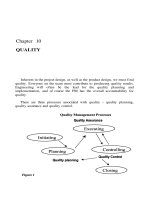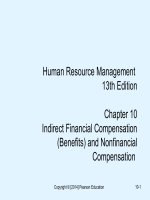Operation management 10e heizer render chapter 10
Bạn đang xem bản rút gọn của tài liệu. Xem và tải ngay bản đầy đủ của tài liệu tại đây (1.04 MB, 45 trang )
Operations
Management
Chapter 10 –
Human Resources
and Job Design
PowerPoint presentation to accompany
Heizer/Render
Principles of Operations Management, 7e
Operations Management, 9e
© 2008 Prentice Hall, Inc.
10 – 1
Outline
Global Company Profile: Rusty
Wallace’s NASCAR Racing Team
Human Resource Strategy
For Competitive Advantage
Constraints on Human Resource Strategy
Labor Planning
Employment-Stability Policies
Work Schedules
Job Classifications and Work Rules
© 2008 Prentice Hall, Inc.
10 – 2
Outline – Continued
Job Design
Labor Specialization
Job Expansion
Psychological Components of Job
Design
Self-Directed Teams
Motivation and Incentive Systems
© 2008 Prentice Hall, Inc.
10 – 3
Outline – Continued
Ergonomics and Work Methods
Methods Analysis
The Visual Workplace
Ethics and the Work Environment
Labor Standards
© 2008 Prentice Hall, Inc.
10 – 4
Learning Objectives
When you complete this chapter you
should be able to:
1.
2.
3.
Describe labor planning policies
Identify the major issues in job design
Identify major ergonomic and work
environment issues
4. Use the tools of methods analysis
5. Understand the contribution of the
visual workplace
© 2008 Prentice Hall, Inc.
10 – 5
Rusty Wallace’s NASCAR
Racing Team
NASCAR racing became very
popular in the 1990s with huge
sponsorship and prize money
High performance pit crews are a
key element of a successful race
team
Pit crew members can earn
$100,000 per year – for changing
tires!
© 2008 Prentice Hall, Inc.
10 – 6
Rusty Wallace’s NASCAR
Racing Team
Each position has very specific
work standards
Pit crews are highly organized
and go though rigorous physical
training
Pit stops are videotaped to look
for improvements
© 2008 Prentice Hall, Inc.
10 – 7
Human Resource Strategy
The objective of a human resource
strategy is to manage labor and
design jobs so people are effectively
and efficiently utilized
1. People should be effectively utilized
within the constraints of other
operations management decisions
2. People should have a reasonable quality
of work life in an atmosphere of mutual
commitment and trust
© 2008 Prentice Hall, Inc.
10 – 8
Schedules
• Time of day
• Time of year
(seasonal)
• Stability of
schedules
When
Process strategy
• Technology
• Machinery and
equipment used
• Safety
Individual differences
Who • Strength and
fatigue
• Information
processing and
response
HUMAN
RESOURCE
STRATEGY
ow
H
Location strategy
• Climate
• Temperature
• Noise
• Light
• Air quality
W
ha
t
W
he
re
Product strategy
• Skills needed
• Talents needed
• Materials used
• Safety
Pr
oc
ed
ur
e
Constraints on Human
Resource Strategy
Layout strategy
• Fixed position
• Process
• Assembly line
• Work cell
• Product
Figure 10.1
© 2008 Prentice Hall, Inc.
10 – 9
Labor Planning
Employment Stability Policies
1. Follow demand exactly
Matches direct labor costs to
production
Incurs costs in hiring and
termination, unemployment
insurance, and premium wages
Labor is treated as a variable cost
© 2008 Prentice Hall, Inc.
10 – 10
Labor Planning
Employment Stability Policies
2. Hold employment constant
Maintains trained workforce
Minimizes hiring, termination, and
unemployment costs
Employees may be underutilized
during slack periods
Labor is treated as a fixed cost
© 2008 Prentice Hall, Inc.
10 – 11
Work Schedules
Standard work schedule
Five eight-hour days
Flex-time
Allows employees, within limits, to
determine their own schedules
Flexible work week
Fewer but longer days
Part-time
Fewer, possibly irregular, hours
© 2008 Prentice Hall, Inc.
10 – 12
Job Classification and
Work Rules
Specify who can do what
Specify when they can do it
Specify under what conditions
they can do it
Often result of union contracts
Restricts flexibility in assignments
and consequently efficiency of
production
© 2008 Prentice Hall, Inc.
10 – 13
Job Design
Specifying the tasks that constitute
a job for an individual or a group
1. Job specialization
2. Job expansion
3. Psychological components
4. Self-directed teams
5. Motivation and incentive systems
© 2008 Prentice Hall, Inc.
10 – 14
Labor Specialization
The division of labor into unique tasks
First suggested by Adam Smith in 1776
1. Development of dexterity and faster
learning
2. Less loss of time
3. Development of specialized tools
Later Charles Babbage (1832) added
another consideration
4. Wages exactly fit the required skill
© 2008 Prentice Hall, Inc.
10 – 15
Job Expansion
Adding more variety to jobs
Intended to reduce boredom
associated with labor specialization
Job enlargement
Job rotation
Job enrichment
Employee empowerment
© 2008 Prentice Hall, Inc.
10 – 16
Job Enlargement
Enriched job
Planning
(Participate in a crossfunction quality
improvement team)
Enlarged job
Task #3
(Lock printed circuit
board into fixture for
next operation)
Present job
(Manually insert and
solder six resistors)
Task #2
(Adhere labels
to printed
circuit board)
Control
(Test circuits after
assembly)
Figure 10.2
© 2008 Prentice Hall, Inc.
10 – 17
Psychological Components
of Job Design
Human resource strategy requires
consideration of the psychological
components
of job design
© 2008 Prentice Hall, Inc.
10 – 18
Hawthorne Studies
They studied light levels, but discovered
productivity improvement was
independent from lighting levels
Introduced psychology into the workplace
The workplace social system and distinct
roles played by individuals may be more
important than physical factors
Individual differences may be dominant in
job expectation and contribution
© 2008 Prentice Hall, Inc.
10 – 19
Core Job Characteristics
Jobs should include the following
characteristics
Skill variety
Job identity
Job significance
Autonomy
Feedback
© 2008 Prentice Hall, Inc.
10 – 20
Job Design Continuum
Self-directed
teams
Empowerment
Enrichment
Enlargement
Specialization
Increasing
reliance on
employee’s
contribution
and
increasing
responsibility
accepted by
employee
Job expansion
Figure 10.3
© 2008 Prentice Hall, Inc.
10 – 21
Self-Directed Teams
Group of empowered individuals
working together to reach a
common goal
May be organized for long-term or
short-term objectives
Effective because
Provide employee empowerment
Ensure core job characteristics
Meet individual psychological needs
© 2008 Prentice Hall, Inc.
10 – 22
Self-Directed Teams
To maximize effectiveness, managers should
Ensure those who have legitimate
contributions are on the team
Provide management support
Ensure the necessary training
Endorse clear objectives and goals
Financial and non-financial rewards
Supervisors must release control
© 2008 Prentice Hall, Inc.
10 – 23
Benefits of Teams and
Expanded Job Designs
Improved quality of work life
Improved job satisfaction
Increased motivation
Allows employees to accept more
responsibility
Improved productivity and quality
Reduced turnover and absenteeism
© 2008 Prentice Hall, Inc.
10 – 24
Limitations of Job
Expansion
1. Higher capital cost
2. Individuals may prefer simple jobs
3. Higher wages rates for greater skills
4. Smaller labor pool
5. Higher training costs
© 2008 Prentice Hall, Inc.
10 – 25









